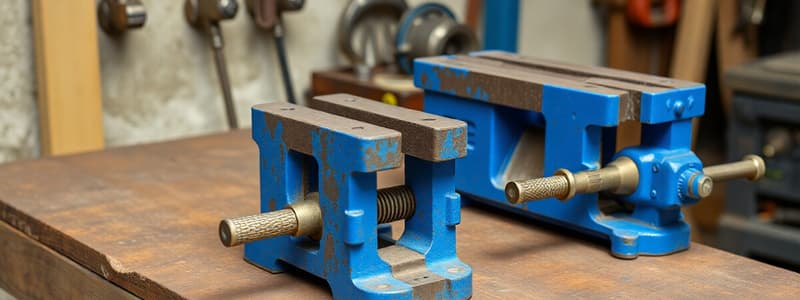Podcast
Questions and Answers
Which of the following is NOT a method used in chiseling?
Which of the following is NOT a method used in chiseling?
- Parting
- Forging (correct)
- Shearing
- Chipping
A large lip angle on a cold chisel requires less force for penetration.
A large lip angle on a cold chisel requires less force for penetration.
False (B)
What is the primary purpose of clamping the workpiece rigidly in the vise when chipping?
What is the primary purpose of clamping the workpiece rigidly in the vise when chipping?
To counteract the forces applied on the head of the cold chisel during the chipping process.
The cutting edge of a cold chisel is shaped like a ______.
The cutting edge of a cold chisel is shaped like a ______.
Match the chiseling methods with their descriptions:
Match the chiseling methods with their descriptions:
Which lip angle is best suited for soft metals?
Which lip angle is best suited for soft metals?
The shearing method uses the full width of the cutting edge to cut across the workpiece.
The shearing method uses the full width of the cutting edge to cut across the workpiece.
Which of the following tools is NOT used with a steel-headed hammer for chipping or cutting material?
Which of the following tools is NOT used with a steel-headed hammer for chipping or cutting material?
Chisels made for general metal work are known as ______ chisels.
Chisels made for general metal work are known as ______ chisels.
Which chisel shape is used for removing damaged rivets?
Which chisel shape is used for removing damaged rivets?
Match the chisel shape with its primary use:
Match the chisel shape with its primary use:
The size of a chisel is determined by its length.
The size of a chisel is determined by its length.
What part of a chisel determines the utilization of applied force?
What part of a chisel determines the utilization of applied force?
Which of the following is NOT a typical use for a straight cutting edge chisel?
Which of the following is NOT a typical use for a straight cutting edge chisel?
In the manufacturing of a chisel, ______ is the process where the metal is heated to a high temperature (2000 to 2500°F) and formed into the cutting edge.
In the manufacturing of a chisel, ______ is the process where the metal is heated to a high temperature (2000 to 2500°F) and formed into the cutting edge.
The process of hardening a chisel involves heating the metal to a high temperature and then quickly cooling it.
The process of hardening a chisel involves heating the metal to a high temperature and then quickly cooling it.
What is the primary function of a wrench?
What is the primary function of a wrench?
Wrenches are only used for tightening nuts and bolts.
Wrenches are only used for tightening nuts and bolts.
What are the two main categories of wrenches based on their primary use?
What are the two main categories of wrenches based on their primary use?
A wrench applies ______ to turn objects.
A wrench applies ______ to turn objects.
Match the type of wrench with its description:
Match the type of wrench with its description:
What is the trade name for a specific type of locking, adjustable plier known as 'wrench pliers'?
What is the trade name for a specific type of locking, adjustable plier known as 'wrench pliers'?
Slip joint pliers have only two points of adjustment.
Slip joint pliers have only two points of adjustment.
Which type of wrench has a 90-degree angle between the handle and the adjustable head?
Which type of wrench has a 90-degree angle between the handle and the adjustable head?
Closed-end wrenches can fit both square and hex nuts.
Closed-end wrenches can fit both square and hex nuts.
What are the two types of slip joint pliers?
What are the two types of slip joint pliers?
Discard any damaged wrenches, such as open-ended wrenches with ______ jaws.
Discard any damaged wrenches, such as open-ended wrenches with ______ jaws.
A wrench that has both an open end and a closed end is called a ______ wrench.
A wrench that has both an open end and a closed end is called a ______ wrench.
Match the type of wrench with its appropriate use:
Match the type of wrench with its appropriate use:
What is the defining characteristic of a socket wrench?
What is the defining characteristic of a socket wrench?
Torque wrenches are designed to apply specific amounts of force to tighten bolts.
Torque wrenches are designed to apply specific amounts of force to tighten bolts.
Which type of wrench is often used to tighten bolts on a car's engine?
Which type of wrench is often used to tighten bolts on a car's engine?
Match the following wrench types with their descriptions:
Match the following wrench types with their descriptions:
______ wrenches are designed for tightening bolts with a specific amount of torque.
______ wrenches are designed for tightening bolts with a specific amount of torque.
What is the primary function of a nut driver?
What is the primary function of a nut driver?
Which type of wrench is commonly used to tighten bolts that have hexagonal heads?
Which type of wrench is commonly used to tighten bolts that have hexagonal heads?
Flashcards
Chiseling
Chiseling
A metal cutting process using a wedge-shaped tool called a cold chisel.
Cold Chisel
Cold Chisel
A cutting tool made of hardened steel used for metalwork.
Parting Operation
Parting Operation
A chiseling method allowing the cutting edge to penetrate by vertical hammer blows.
Chipping
Chipping
Signup and view all the flashcards
Shearing
Shearing
Signup and view all the flashcards
Lip Angle
Lip Angle
Signup and view all the flashcards
Safety in Usage
Safety in Usage
Signup and view all the flashcards
Wrench
Wrench
Signup and view all the flashcards
Types of Wrenches
Types of Wrenches
Signup and view all the flashcards
Pipe Wrench
Pipe Wrench
Signup and view all the flashcards
General Use Wrench
General Use Wrench
Signup and view all the flashcards
Adjustable Wrench
Adjustable Wrench
Signup and view all the flashcards
Crescent Wrench
Crescent Wrench
Signup and view all the flashcards
Loosening
Loosening
Signup and view all the flashcards
Fastening
Fastening
Signup and view all the flashcards
Safety with Wrenches
Safety with Wrenches
Signup and view all the flashcards
Chisel Function
Chisel Function
Signup and view all the flashcards
Types of Chisels
Types of Chisels
Signup and view all the flashcards
Damaged Rivet Chisel
Damaged Rivet Chisel
Signup and view all the flashcards
Creating Sharp Corners Chisel
Creating Sharp Corners Chisel
Signup and view all the flashcards
Cutting Keyways Chisel
Cutting Keyways Chisel
Signup and view all the flashcards
Concave Grooves Chisel
Concave Grooves Chisel
Signup and view all the flashcards
Chisel Size Determinant
Chisel Size Determinant
Signup and view all the flashcards
Applied Force in Chiseling
Applied Force in Chiseling
Signup and view all the flashcards
Chisel Manufacturing Process
Chisel Manufacturing Process
Signup and view all the flashcards
Types of Pliers
Types of Pliers
Signup and view all the flashcards
Vise-Grip Pliers
Vise-Grip Pliers
Signup and view all the flashcards
Slip Joint Pliers
Slip Joint Pliers
Signup and view all the flashcards
Water-Pump Pliers
Water-Pump Pliers
Signup and view all the flashcards
Wrench Safety Tips
Wrench Safety Tips
Signup and view all the flashcards
Monkey Wrench
Monkey Wrench
Signup and view all the flashcards
Open Ended Wrench
Open Ended Wrench
Signup and view all the flashcards
Closed End Wrench
Closed End Wrench
Signup and view all the flashcards
Combination Wrench
Combination Wrench
Signup and view all the flashcards
Socket Wrench
Socket Wrench
Signup and view all the flashcards
Torque Wrench
Torque Wrench
Signup and view all the flashcards
Nut Driver
Nut Driver
Signup and view all the flashcards
Allen Wrench
Allen Wrench
Signup and view all the flashcards
Ratchet Handle
Ratchet Handle
Signup and view all the flashcards
Recessed Hole
Recessed Hole
Signup and view all the flashcards
Study Notes
Holding Devices
- Holding tools, also known as work-holding devices, are used to hold components in bench work.
- Common devices include vises with fixed and movable jaws.
- Choose a vise appropriate for the strength required for the work.
- Wear safety glasses or goggles, or a face shield when using tools or machinery on items held by a vise.
- Securely attach the vise to the workbench.
- Position workpieces close to the vise jaws to prevent vibrations.
- Support long workpieces using saw horses or other supports.
- Keep mechanical parts lubricated and free of debris.
Bench Vises
- Bench vises are a common work-holding device.
- They are mounted firmly to a workbench using nuts and bolts.
- Vises typically have a fixed jaw and a movable jaw.
- The movable jaw is adjusted using a handle.
- The jaws are used to hold workpieces.
Pipe Vises
- Pipe vises resemble bench vises.
- Pipe vises are designed for holding cylindrical components.
- Their shape accommodates the curvature of existing components.
- Workpieces can be securely clamped between the jaws.
Toolmaker's Vises
- Toolmaker's vise is used when a strong clamping force is needed.
- Fixed jaw and movable jaw.
- Movable jaw is tightened by a screw.
- Made from hardened alloy steel.
- Jaw surfaces are precisely ground, square, and parallel.
Hand Vises
- Hand vises are designed to hold work pieces between its jaws.
- The wingnut tightens the vise in one direction.
- The wingnut loosens the vise in the other direction.
Safety Precautions
- Inspect tools before use for any damage.
- Ensure a secure grip on tools to prevent slippage.
- Maintain good posture and balance while working.
- Use appropriate personal protective equipment (PPE).
- Follow instructions on tool operation for added safety measures.
Studying That Suits You
Use AI to generate personalized quizzes and flashcards to suit your learning preferences.




